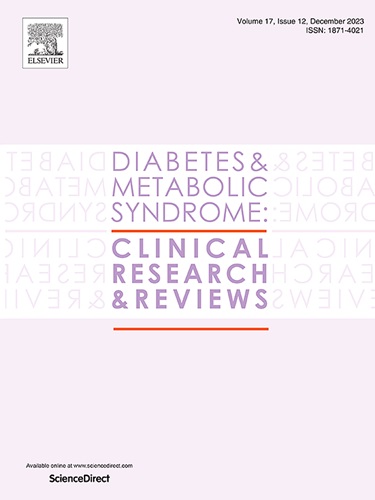残余胆固醇对接受冠状动脉血运重建手术的印度受试者血脂管理的指导意义。
IF 3.4
Q1 ENDOCRINOLOGY & METABOLISM
Diabetes & Metabolic Syndrome-Clinical Research & Reviews
Pub Date : 2025-01-01
DOI:10.1016/j.dsx.2024.103183
引用次数: 0
摘要
背景:残余胆固醇是指血液循环中富含甘油三酯的非低密度脂蛋白(LDL)颗粒的胆固醇含量,其致动脉粥样硬化的潜力最近受到越来越多的关注。不幸的是,关于印度人体内残余胆固醇水平的信息非常有限。方法:这是一项回顾性研究,在印度北部的一级三级保健中心进行。共纳入3064名连续接受冠状动脉重建术的新诊断冠状动脉疾病(CAD)患者[平均年龄61.3±10.3岁,2550名(83.2%)男性]。酶法测定各种脂质参数。残馀胆固醇由总胆固醇减去LDL- c和高密度脂蛋白胆固醇计算。bb0 ~ 30mg /dL被认为是升高。结果:平均LDL-C为79.1±33.1 mg/dL,其中46.4%的受试者LDL-C为30 mg/dL。只有4.5%的患者LDL-C达到200 mg/dL。结论:我们的研究表明,在患有冠心病的北印度人群中,残余胆固醇升高仅占一小部分。随着LDL-C控制的改善,残余胆固醇升高的发生率进一步降低。这些发现表明,对于大多数LDL-C低于目前推荐目标的患者,残余胆固醇升高可能不是临床相关的治疗靶点。本文章由计算机程序翻译,如有差异,请以英文原文为准。
The relevance of remnant cholesterol as a guide for lipid management in Indian subjects undergoing coronary revascularization
Background
The atherogenic potential of remnant cholesterol, which refers to the cholesterol content of triglyceride-rich, non-low-density lipoprotein (LDL) particles in circulation, has gained increasing attention recently. Unfortunately, very limited information is available regarding remnant cholesterol levels in Indian subjects.
Methods
This was a retrospective study conducted at a premier, tertiary care center in North India. A total of 3064 consecutive subjects [mean age 61.3 ± 10.3 years, 2550 (83.2%) men] with newly diagnosed coronary artery disease (CAD) undergoing coronary revascularization were included. Enzymatic assays were used for measuring various lipid parameters. Remnant cholesterol was calculated by subtracting LDL cholesterol (LDL-C) and high-density lipoprotein cholesterol from total cholesterol. A value >30 mg/dL was considered elevated.
Results
The mean LDL-C was 79.1 ± 33.1 mg/dL with 46.4% of all subjects having LDL-C <70 mg/dL and only 16.9% having LDL-C <50 mg/dL. The median remnant cholesterol level was 17.0 mg/dL (interquartile range 12.0–24.0 mg/dL) with only 11.9% of subjects having values >30 mg/dL. Only 4.5% of the patients with LDL-C <70 mg/dL and 2.9% of those with LDL-C <50 mg/dL had elevated remnant cholesterol. These proportions were significantly greater in patients with serum triglycerides >200 mg/dL.
Conclusion
Our study shows that in a North-Indian population with CAD, elevated remnant cholesterol was present in only a small proportion. The prevalence of elevated remnant cholesterol decreased further as the LDL-C control improved. These findings suggest that elevated remnant cholesterol may not be a clinically relevant therapeutic target in most patients with LDL-C below the currently recommended goals.
求助全文
通过发布文献求助,成功后即可免费获取论文全文。
去求助
来源期刊

Diabetes & Metabolic Syndrome-Clinical Research & Reviews
ENDOCRINOLOGY & METABOLISM-
CiteScore
22.90
自引率
2.00%
发文量
248
审稿时长
51 days
期刊介绍:
Diabetes and Metabolic Syndrome: Clinical Research and Reviews is the official journal of DiabetesIndia. It aims to provide a global platform for healthcare professionals, diabetes educators, and other stakeholders to submit their research on diabetes care.
Types of Publications:
Diabetes and Metabolic Syndrome: Clinical Research and Reviews publishes peer-reviewed original articles, reviews, short communications, case reports, letters to the Editor, and expert comments. Reviews and mini-reviews are particularly welcomed for areas within endocrinology undergoing rapid changes.
 求助内容:
求助内容: 应助结果提醒方式:
应助结果提醒方式:


